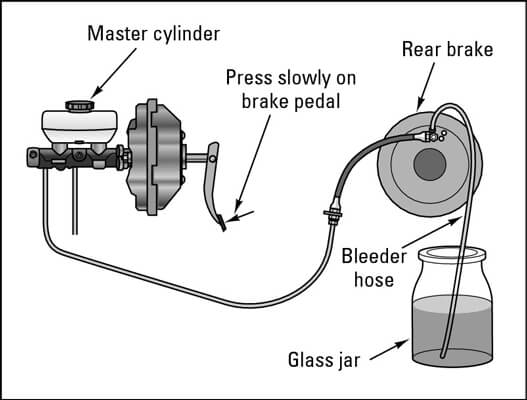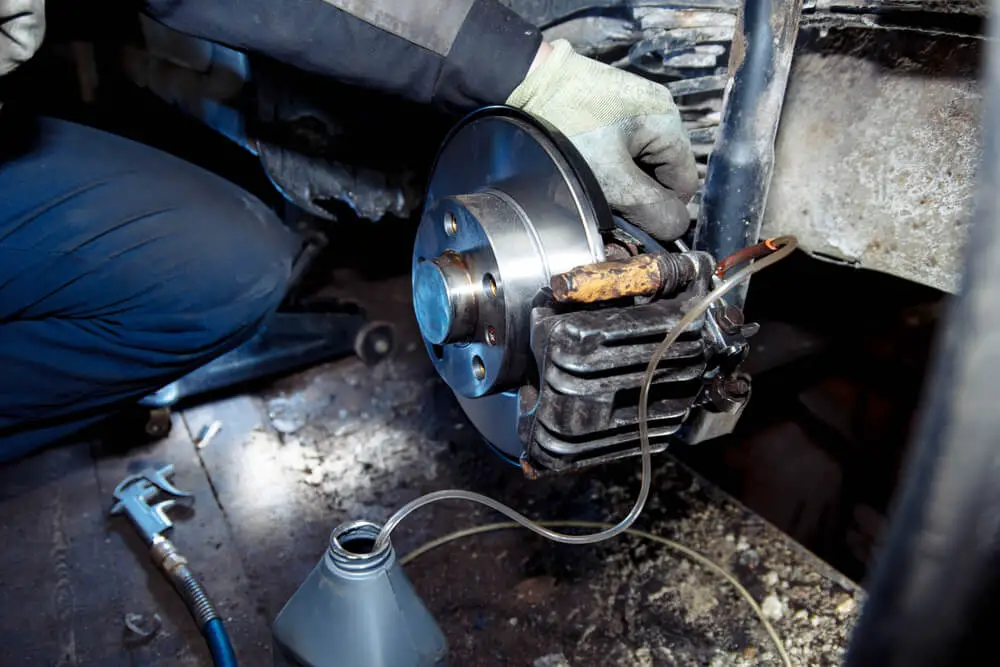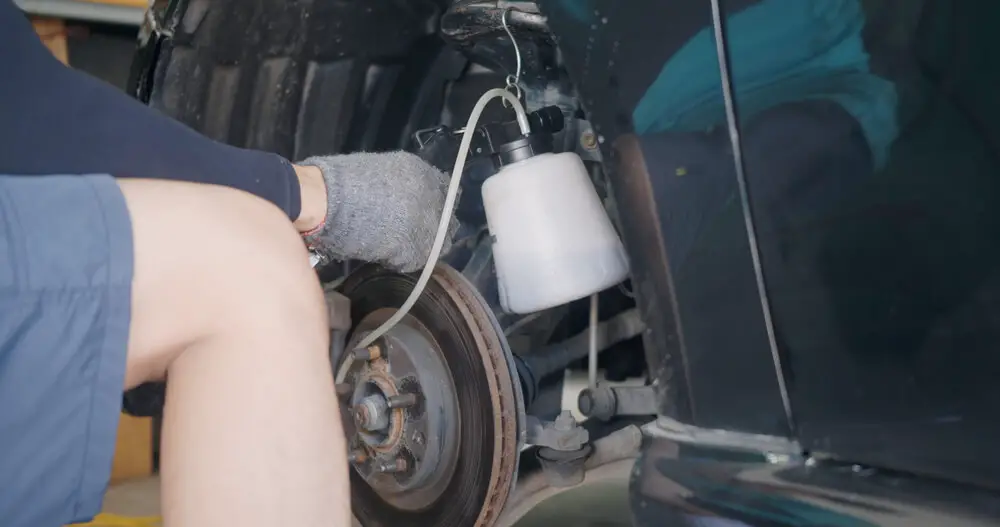Hey there! This post contains affiliate links to products. We may receive a commission for purchases made through these links. But it never influences our product selection process.
Brake bleeding is not common, but you need it when flushing the fluid or changing the brake lines especially of your Dodge Ram pickup vehicles. Proper brake bleeding is essential and you need to maintain the correct bleeding sequence for the efficient performance of brakes. But how to maintain a dodge ram brake bleeding sequence?
It is pretty simple, get a high-end scanner, and attach the scanner to the vehicle to scan for the bleeder front. Attach the hose to the bleeder and adjust it with a wrench to get the right level of bleeding. Keep checking the air bubbles and ensure no bubbles. Once it has been done, repeat the same process for all four corners.
You have several methods to dodge ram brake bleeding; here, you will be guided in the most authentic way. So, continue reading this blog to end and get the right brake system bleeding sequence.
What is the brake bleeding sequence?

The brake bleeding sequence means from where you start the bleeding process and where to end. The sequence should be correct when you want safe performance from your vehicle brake system.
You will have to protect the brake line system from drying once you have followed the correct brake bleeding sequence.
In modern vehicles, the brake bleeding sequence always starts with the caliper farthest from the main cylinder working on the way back to the closest one. Make sure your main cylinder top remains wet with brake fuel.
Proper brake bleeding sequence in the vehicles that ensure consistent brake fuel in brake lines is as follows.
- Right rear
- Left rear
- Right front
- Left front
Why Dodge ram brakes won’t bleed? 4 possible reasons

After a couple of drives, it is a common issue that the brake line system is not performing as expected. You have the correct brake line bleeding sequence, but dodge ram brakes won’t bleed.
The major reason is that the brake pedal level is too low, which causes the inconsistent flow of brake fluid. Whenever you experience this situation, here are the few most occurring reasons.
Loose bleed Screw:
On the highest point of the brake caliper, you have the bleed screw that works as a valve for bleeding air in the brake fluid. The screw is located in the brake caliper, but behind the wheel, that is not a friendly space.
The environment is challenging; because of too much dust and debris in this area, screws may quickly damage.
You may experience corrosion in the screw that may make it jam and stop it from freely moving. So, because of blockage in the bleeding passage, brake fuel cannot properly bleed.
You can easily replace the screw to ensure a proper bleeding process. But make sure you have the right Brake Bleeder Kit for quick completion of the job.
HTOMT 2 in 1 Brake Bleeder Kit could be the right set of tool kit with Protected Case and Clutch Bleeding System.
Sometimes you have the screw in good condition, but it is loose, or its cap is damaged. You can replace the Brake Bleeder Screw Caps and in this regard, UTSAUTO Brake Bleeder Screw Caps could be best to resolve the problem. It will not take more than 10 minutes to diagnose and fix.
Damaged Brake Flex Hose:
A damaged or poor-quality flex hose can cause brakes to bleed. Brake fluid comes from the master cylinder to the brake caliper, so if the flex hose has a cut or damage, it will affect the brake fluid supply.
It will cause a decrease in pressure in the brake system, which also reduces the bleeding. You may experience inconsistent or complete failure of the brake bleeding system.
You can replace the damaged flex hose easily but make sure you have a good quality air brake bleeder kit for the perfect replacement.
FOUR UNCLES 2L Vacuum Brake Bleeder Kit is my recommendation for the replacement job. You may create a mess if you do not have all the necessary tools.
Faulty caliper’s sliding pins:
Another reason that is hard to identify and fix when the brake bleeder is not working can be faulty caliper’s sliding pins. The best solution is to replace the pins to eliminate the problem.
But also check for the leakage in the oil seal in your brake caliper pistons. Sometimes faulty seals of the brake caliper pistons also cause dryness that stops sliding pins from movement. If sliding pins are okay, but the problem is with seals, replace them.
Faulty Brake fluid Bleeder:
A faulty brake fluid bleeder also causes dodge ram brakes won’t bleed. It may be corroded, damaged, or of low quality that does not meet the requirements.
If you have a faulty brake fluid bleeder, replace it with a new one for consistent performance.
ARES 70923-1-Liter Vacuum Brake Fluid Bleeder could be your right choice because it is easy to use and works like a charm.
You may also like: Honda lanewatch camera not working
Dodge ram brake bleeding sequence [1500, 2000, 2001, 2005 Model]

There are several dodge ram models in the market, such as 1500, 2000, 2001, and 2005. As a newbie, a question arises: Do different models have different brake bleeding sequences?
The simple answer is no. Whatever Dodge Ram model you have, the brake system bleeding sequence is the same. The correct sequence for all models is right rear, left rear, right front, and left front.
How do you bleed the abs on a dodge ram?
Your brake line bleeding system needs a proper sequence of the dodge ram for exemplary performance. The traditional dodge ram system is different from the modern abs on dodge ram system.
You only need air in the brake to bleed like usual in a conventional dodge ram system. But in abs on a dodge ram, you have a little motor that controls a bunch of valves inside of it.
It assists pulse the brakes you do not end up in and saves you from serious situations. For excellent performance, ensure the right way to bleed the abs on a dodge ram.
Read this abs brake bleeding sequence guide to learn the correct way to bleed the abs on a dodge ram.
Step-by-step guide: Bleed the abs on a dodge ram
It may be a complex job as a newbie; if you follow the below step-by-step guide, it will become easier to bleed the abs on a dodge ram.
Things you will need:
- High-End Scanner
- Wrench
- Hose
- measuring jar
- Gloves
Step 1: Scanning
- Start plugging in the scanner, insert your vehicle key in the ignition lock, and turn it to the second position. Leave the key to the second position. Make sure the ignition is on, but the engine is off. You will be able to perform scanning for the brake fluid bleed.
- For the scanning, go to your vehicle display screen and follow the below steps.
- Click on the “service.”
- From the available screen, click on “Brake Bleed”
- You will see the options to choose from, but from the right top bottom, select the “Auto detect” to start the scanning process, wait, and find your vehicle. Once found, click on your vehicle.
- The Diagnosis process will start, and you will be asked to provide VIN information. If you select auto to detect, it will automatically pick the VIN. Press “OK,” and you will see the vehicle details.
- Then hit the “hot function,” and you will get access to the Abs brake bleed system. Click on Abs brake bleed and select the analog brake speed.
- It will give you instructions for the right abs brake bleeding sequence.
- First, you will be asked to open the left front bleeder screw and attach the fluid container.
Step 2: Remove the dust cap
To open the front bleeder and attach the container, Go to the brake line system and remove the dust cap. It is the same as the traditional brake line system.
Step 3: Attach the hose
Now attach the recommended size hose with the bleeder. Attach the hose’s one end with a bleeder and the second to a measuring jar to collect the fluid.
First, fit the wrench on the bleeder front and then attach the hose. Adjust the bleeder with a wrench and keep running the fluid from the hose. Keep checking to get the right adjustment. You will see the jar is filled with fluid.
Keep checking if the hose ever sucks the air or not. When ensuring you have done the right job. Tighten the fitting back. Remove the hose and reinstall the dust cap.
Follow the same process for all four corners; once done, push the accelerator for a couple of minutes to complete the bleeding for all corners.
You will see a processing line; wait till completion. Is it completed? You can use FOXWELL NT630 Plus OBD2 Scanner ABS SRS Scan Tool for accurate and professional diagnosis of your ABS Auto Bleed process.
How much do bleeding brakes cost?
Bleeding brakes generally cost between 40 to 60 dollars for most automobile types. If you have Dodge Ram 1500 brake bleeds, then the average cost would be between $60 to $80 (without fees and taxes).
Frequently Asked Questions (FAQs)
Is it essential to bleed all 4 brakes?
Yes, it is recommended by the experts to bleed all 4 brakes when you open one of the brake lines to replace the caliper or for any other work with the brake line.
How can I get the air out of the brakes without bleeding?
Start your vehicle and press each brake pedal 15 to 20 times to remove air from the brakes.
Can I bleed the brakes from the master cylinder?
Yes, you can bleed the brakes from the master cylinder. But it is time-consuming, and you will need help from another person to watch the bubbles when you press the brake pedal.
How much time is needed to remove the air out of brake lines?
It may take an hour for the complete process. You may need 15 minutes to locate the brake lines in your vehicle; once discovered, it will take 45 minutes or more to remove air.
Conclusion
Brake bleeding sequence matters in your brake line performance. If you have the wrong sequence, it will cause air bubbles, making brake lines dry and not work. Irregular bleeding will damage the brake line or other parts; it is also a big risk while driving. You can keep the dodge ram brake bleeding sequence in orderly but first, carefully read the brake bleeding sequence guide.

